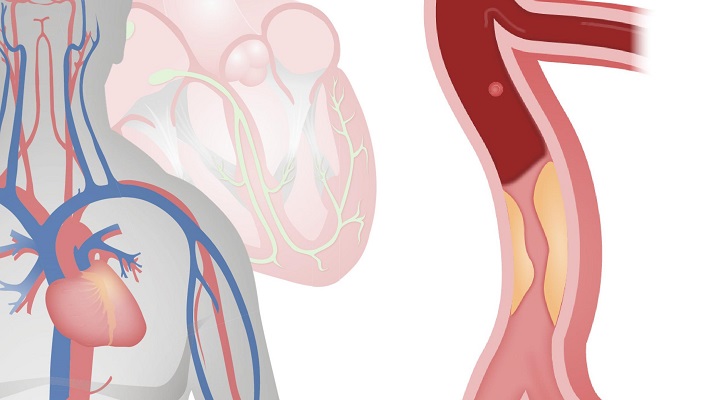Coronary artery disease (CAD) affects the coronary arteries that supply blood to the heart. In this disease, deposits cause narrowing or blockage of one or more coronary arteries. Coronary artery disease usually causes chest pain (angina) and can have complications such as heart attack, heart failure, or arrhythmia. Continue reading the article to learn more about this disease’s symptoms, causes, and treatments.
What is coronary artery disease?
This disease causes the narrowing or blockage of the coronary arteries and is usually caused by the accumulation of fatty plaques. Coronary arteries are responsible for delivering oxygen-rich blood to the heart. Accumulation of plaques in these arteries reduces the blood supply to the core.
Imagine that two street lanes have become one lane due to repairs. In this mode, traffic flows but more slowly than usual. In people with coronary artery disease, there may be no problems initially until the fatty plaque causes a clot. The clot closes the road like a cement barrier, and traffic stops. In this case, the blood cannot reach the heart, and this causes a heart attack.
A person may have coronary artery disease for years but have no symptoms until a heart attack. For this reason, this disease is also called the silent killer. This complication is also called coronary heart disease and ischemic heart disease.
Types of coronary artery disease
Coronary heart disease can be seen in two ways:
- Stable ischemic heart disease: This type of disease is chronic. Coronary artery disease causes the narrowing of the arteries gradually over the years. Over time, the heart receives less oxygen-rich blood, and you may experience symptoms, but it won’t cause any problems in your daily life.
- Acute coronary syndrome: This type occurs suddenly and is a medical emergency. Fatty plaques in a coronary artery suddenly rupture, forming a blood clot and blocking blood flow to the heart. This sudden blockage causes a heart attack.
Why does coronary artery disease occur?
Plaque (a combination of cholesterol, fat, and other substances) may begin to stick to the walls of arteries even from childhood. This plaque grows more significant over time and causes the streets to become narrower and stiffer, called atherosclerosis. In some cases, this fatty plaque can rupture or break. After that, blood cells called platelets try to repair the artery and form a blood clot.
Like a blocked pipe, this blockage prevents blood from reaching the arteries, and insufficient oxygen and nutrients reach the heart. This complication causes symptoms such as shortness of breath and chest pain. Without enough oxygen, the heart may become weaker. This causes an irregular heartbeat (arrhythmia). It can also cause heart failure, meaning the heart cannot pump as much blood as the body needs.
If the fatty plaque becomes large enough to cut off blood flow, it can cause a heart attack. Of course, in most cases, heart attacks occur due to smaller plaques that rupture.
Symptoms of coronary artery disease
Symptoms of this disease may not appear for a long time. Coronary artery disease is a chronic complication. Fatty plaque build-up can take years or even decades. As the arteries narrow, mild symptoms will be seen. These symptoms indicate that the heart is working harder to reach oxygen-rich blood.
Symptoms of chronic coronary artery disease include:
- Persistent angina: This is the most common symptom of the disease. Persistent angina involves chest pain and discomfort that comes and goes in a predictable pattern. Usually, a person experiences this symptom during physical activity or emotional disturbance, and the sign disappears with nitroglycerin.
- Shortness of breath: Some people experience shortness of breath during light physical activity.
Sometimes the first symptom of coronary artery disease is a heart attack. Some symptoms of a heart attack include:
- Chest pain or angina. Angina may vary from mild discomfort to severe pain. This feeling can be like heaviness, tightness, pressure, pain, burning, numbness, fullness, stress, or vague ache, and the discomfort can spread to the shoulder, arm, neck, back, or jaw.
- shortness of breath or difficulty breathing;
- feeling dizzy or lightheaded;
- A feeling of intense heart palpitations;
- feeling tired;
- Nausea, stomach upset, or vomiting that may feel like indigestion ;
- weakness
Women may experience more unusual symptoms, such as:
- Shortness of breath, bruises, insomnia that start before a heart attack.
- Back, shoulder, neck, arm, and stomach pain.
- Strong heartbeat.
- Feeling hot or flushed.
What factors increase the probability of coronary artery disease?
Coronary artery disease has various underlying factors, some of which cannot be controlled, and some can be controlled by changing lifestyles or taking medication.
Uncontrollable underlying factors
- Age: With increasing age, the probability of contracting this disease increases. Men after the age of 45 and women after the age of 55 are more susceptible to this condition.
- Family history: If a person’s family members have heart disease, the risk of getting it increases. Especially if they have premature heart disease, their father or brother had heart disease before age 55, and their mother or sister before age 65.
Background factors related to lifestyle
- A diet rich in saturated fat or simple carbohydrates;
- immobility ;
- lack of sleep ;
- Smoking cigarettes, e-cigarettes, or any tobacco.
The underlying diseases of this condition
- atherosclerosis;
- high blood pressure;
- high bad (low-density lipoprotein) cholesterol;
- high triglycerides;
- Anemia ;
- autoimmune disease, including lupus and rheumatoid arthritis ;
- chronic kidney disease;
- diabetes ;
- Stress;
- homocysteine;
- AIDS;
- metabolic syndrome ;
- obesity and overweight;
- Sleep disorders such as sleep apnea.
Factors that affect women
- Early menopause (before 40 years old);
- endometriosis ;
- history of gestational diabetes, eclampsia, and preeclampsia ;
- Hormonal contraception.
Diagnosis of coronary artery disease

During a physical examination, the doctor will:
- blood pressure measurement;
- listening to the heartbeat with a stethoscope;
- Asking about the person’s symptoms and their time;
- Questions about medical history;
- Lifestyle review;
- Asking about family history, i.e., heart disease of parents, siblings.
Disease diagnosis tests
Your doctor may prescribe one or more of these tests:
- Blood test: This test looks for compounds that damage the arteries and increase the risk of coronary artery disease.
- Angiography (cardiac catheterization): This test sends tubes into the coronary arteries to evaluate or confirm the disease. This test is the primary test for diagnosing coronary artery disease.
- Computed tomography (CT) angiography of the coronary arteries: Using CT and contrast dye, this test displays a three-dimensional image of the heart’s movement and can identify coronary artery blockages.
- Coronary calcium scan: This test measures the amount of calcium in the walls of the coronary arteries, which is a sign of atherosclerosis. Of course, this test does not contribute to the definitive diagnosis of the disease, but it determines the possibility of arterial vessel disease.
- Echocardiogram: uses sound waves to determine the function and structure of the heart.
- Electrocardiogram (EKG): This test measures the heart’s electrical activity and can detect old or new heart attacks, ischemia, and heart rhythm problems.
- Exercise test: In this test, the heart’s response to intense activity is measured and can be effective for diagnosing angina and blockages in the coronary arteries.
Treatment of coronary artery disease
Treatment of this disease usually includes lifestyle changes, management of risk factors, and medication. Some people will also need medical and surgical procedures. Talk to your doctor about the best treatment option for you. Strict adherence to the treatment plan reduces the possibility of dangerous complications of coronary artery disease.
1. changing lifestyle
Making changes in lifestyle can play an essential role in controlling this disease. These changes include:
- Quit smoking, vaping, and other types of tobacco.
- A healthy diet and reducing the consumption of sodium, saturated fats, trans fats, and sugar. For example, the Mediterranean diet can reduce the risk of heart attack and stroke.
- Thirty minutes of walking five days a week or doing a sport or activity you like.
- Reduce alcohol consumption.
Consult your doctor before starting a new exercise program. Your doctor can also advise you on appropriate changes, healthy eating plans, and ways to quit smoking.
2. Management of risk factors
Managing factors that cause coronary artery disease can slow the progression of the disease. You can consult your doctor to address these factors:
- diabetes;
- high blood pressure;
- high cholesterol ;
- high triglycerides;
- Obesity or overweight.
3. taking medication
In addition to treating the symptoms of the disease, drugs also make it easier to control the risk factors. The doctor may prescribe one or more of the following drugs:
- Blood pressure lowering drugs;
- Cholesterol-lowering drugs;
- Medicines to manage persistent angina, such as nitroglycerin and ranolazine;
- Medicines to reduce the risk of blood clots.
4. surgery
- Percutaneous coronary intervention (PCI): another name for this operation is coronary angioplasty, performed with minimal invasion. The doctor uses a small balloon to open the blocked artery and improve blood flow. A stent may also be used to keep the streets open.
- Coronary artery bypass graft (CABG): This surgery creates a new path for blood flow to move around the blockage. This diverts blood flow back to the heart. This procedure is done for people with severe blockages in multiple coronary arteries.
Prevention of coronary artery disease
Coronary artery disease is not always preventable because some risk factors cannot be controlled. Of course, various methods help reduce the risk of this complication and play a role in maintaining the disease. You can prevent coronary artery disease from developing or worsening by taking these measures:
1. Take quitting smoking and tobacco seriously
Quitting an addictive substance is complex and does not come down to willpower alone. That’s why using all the resources and support you can, including your doctor, is good.
2. Follow a heart-healthy diet
Avoid foods rich in saturated fat, trans fat, sodium, and sugar. Eating less simple carbohydrates (such as white bread and pasta) is also good. Replace these foods with whole grains (such as whole wheat bread and brown rice ) and learn more about how nutrition affects cholesterol levels. Excessive alcohol consumption also damages the heart.
3. Get enough sleep
Most adults need 7 to 9 hours of quality sleep a night. Of course, most people may find this difficult or even impossible. Work schedules, children, and other responsibilities can get in the way of getting enough sleep. Talk to your doctor about ways to get enough sleep.
4. Have a healthy weight
Talk to your doctor about your ideal weight and reasonable goals. Avoid short and restrictive diets and look for practical lifestyle changes that can be done in the long term.
5. Be aware of your heart condition
Screening from age 20 (or earlier if necessary) is good. The doctor can evaluate you with simple tests such as blood pressure and body mass index and measure the possibility of heart disease in the future.
6. Be more active
Regular and planned exercise is essential. It is good to exercise for at least 150 minutes a week. You can also incorporate more activities into your daily life; For example, park the car further away from your workplace or stay at your place.
7. Take your medications regularly
Medications are essential to reduce the risk of coronary artery disease and reduce the risk of a heart attack. Most of these drugs should be taken until the end of life. It is good to learn more about the effect of medications to prevent the complications of coronary artery disease and prolong your life.
final word
Coronary artery disease may occur without obvious symptoms and may not be diagnosed until severe complications occur. The best way to deal with this disease is to prevent its underlying factors. With some lifestyle changes, the risk of this disease will decrease significantly, and even its complications will appear later. Even after the diagnosis of coronary artery occlusion, one of the essential treatment measures is to lead a healthier lifestyle. So, we suggest you keep the prevention tips in mind and remove the underlying factors of this disease from your life as much as possible.
Warning! This article is only for educational purposes; to use it, it is necessary to consult a doctor or specialist.



